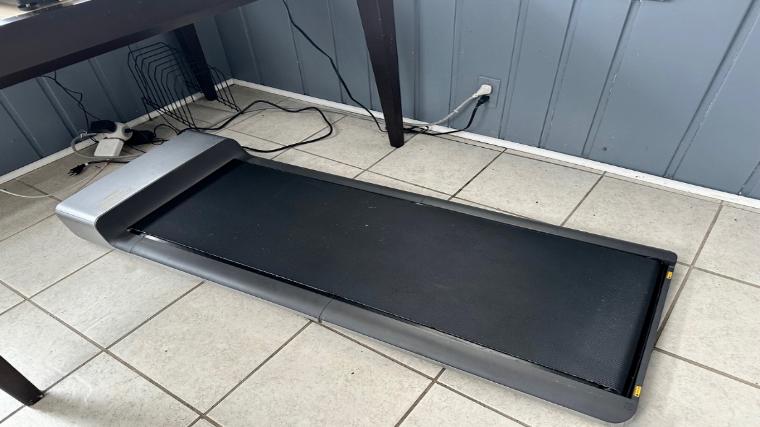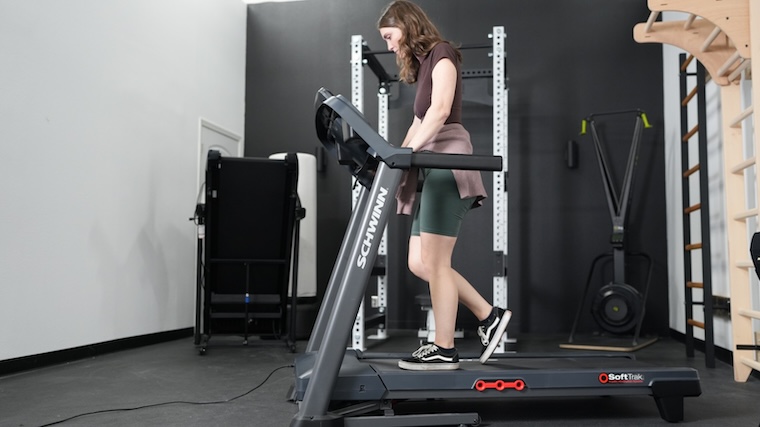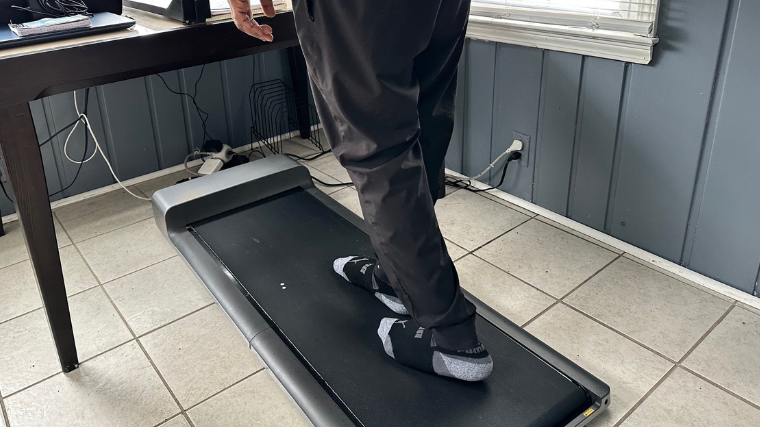Since working from home skyrocketed in many industries during the pandemic, figuring out how to maintain or develop fitness while stuck in the house has been a must for many people. Hence the increase in popularity of home gym equipment like walking pads in the last few years.

But are the weird little handlebar-free treadmills — also known as under-desk treadmills — actually worth it? Just how much superior balance do you need to have to send that email, correct that spreadsheet, and keep from tipping over Miss Congeniality-style during your stroll? Here, I’ll lay it all out for you. Are walking pads worth it? You’re about to find out.
What Is a Walking Pad?
A walking pad, aka a walking pad treadmill or under-desk treadmill, is a smaller version of the conveyor belt part of a traditional treadmill (without handlebars). Walking pads take up less space, and some are even foldable. You can keep one in your home office to move more during the workday or bring it to your living room to walk while watching TV.
Walking Pad Vs. Treadmill
Unlike a folding treadmill, Peloton, or other pieces of home fitness equipment that you can use during a break in the workday, you can use a walking pad while you WFH (work from home).
Treadmills are larger and take up space, but they have handrails, faster speeds, higher inclines, and heavier weight limits. You can use a treadmill to run, incline walk, do HIIT workouts, or train for a marathon.
A walking pad doesn’t have handlebars — look Ma, no hands! — but if you put it under your standing desk, the top of the desk can still help you keep your balance. They typically have a remote control to adjust the walking speed and incline.

[Read More: The Best Budget Treadmills on the Market]
There are many brands of walking pads with different specs. As they’ve become more popular, more affordable options have become available on platforms like Amazon and Target. One brand that went viral on TikTok, Urevo, has walking pads for under $200.
Some have a weight limit of 265 pounds (not very high) and a maximum speed of four miles per hour (not very fast). Others may reach a 300-pound weight limit with slightly faster walking speeds and incline options.
How to Use a Walking Pad at Work
Walking pads are popular in the era of more people working from home, but many in-person offices also offer standing desks and under-desk treadmills. Whatever situation you’re in, here’s how to set it up for proper ergonomics.
- Desk Height: Some standing desks are adjustable, so you can raise them to the right spot. A good rule of thumb is to raise your standing desk to about elbow height or higher to bend your elbows at a 90-degree angle.
- Wrist Position: When you type, your wrists should align with your elbows or be slightly below them. This position minimizes pressure on your nerves and elbow and wrist joints.
- Eye Level: Once you have your desk in the right spot, you may need to elevate your monitor so it’s at eye level. You want to be looking straight ahead, so you don’t need to overly extend or flex your neck to look up or down.
- Ergonomic Equipment: This optimal setup may require a separate keyboard and mouse from your laptop. If you don’t want to purchase a separate monitor, you can elevate your laptop and use it as a screen.
- Ease of Use: Is it difficult to work or type while using a walking pad or under-desk treadmill? Yes, there may be a learning curve at first. You may need to walk slower to get used to multitasking and improve your balance. If you increase your walking speed, you may be working slower.
- One study found that work performance may initially decline as workers get used to using their under-desk treadmills. To shorten the adjustment period, the researchers suggest training the employees to walk and work simultaneously. (1)
Note: “Ease of use” is relative here, even with a desk to help you brace your hands. Here’s what I mean:
Some of my personal training clients can jump onto a manual treadmill — you know, the curved ones where the belt only moves because you’re running on it — and look like they’re flying, no problem. Others…well, everyone has different strengths, and impeccable balance isn’t for everybody.
[Read More: The Best Folding Treadmills (Expert Tested)]
If you fall into that latter category, you’ll probably want to work on your coordination and balance before investing in a walking pad. It’s not just the lack of handlebars — because you’ll likely have a desk under you — but not being able to see your feet can be disorienting for many. If you get easily sidetracked by a sudden notification, typing, or even just walking on an unnatural surface, you might want to stick to typical treadmills.
Walking Pad Benefits
Walking pads’ main benefit is multitasking — walking while you WFH (or watch TV). Here are four health benefits of getting more physical activity during the day outside your regular workouts.
It Helps You Reach Your Cardio Goals
Do you get enough cardio in your life?
Reaching this recommendation improves cardiovascular health and helps prevent heart disease. (2)
Sure, you’re not going for a run, but walking at 3.0 to 4.0 speed for 30 to 45 minutes should sufficiently raise your heart rate to get you in the moderate-intensity zone. Doing it a few times a week while you work is enough to reach your cardio goals and boost your heart health.
It Increases Your Step Count
Walking pads aren’t for crushing high-intensity workouts, but increasing your step count by walking more is a huge plus. Whether you’re aiming for 10,000 steps a day or just trying to walk more than you do now, walking while you work is an easy place to add more steps.
[Read More: Is Walking Good Cardio? Certified Personal Trainers Explain]
Many studies find that getting more steps is associated with a lower risk of all-cause mortality and cardiovascular diseases, though research is mixed on the perfect number. Health benefits seem to level off at 10,000 steps — seven to eight thousand may be sufficient. Even getting 2,000 steps a day has health benefits for people with a sedentary lifestyle. (3)(4)
It Helps Combat a Sedentary Lifestyle
Being sedentary refers to the time you spend inactively sitting, reclining, or lying down — not including sleeping.
Interestingly, even people who regularly exercise tend to spend too many sedentary hours during the day. One meta-analysis found that sedentary individuals who regularly engage in more than one hour of moderate-intensity exercise daily had slightly less risk of dying than those who didn’t. (5)
Still, many studies suggest that more sedentary time — independent of exercise — is associated with a higher risk of all-cause mortality, heart disease, and type 2 diabetes. (5)

[Read More: The Best Treadmill Walking Workouts From a CPT (+ Insight From a Conditioning Coach)]
And the research gets more demoralizing. It suggests that six to eight hours a day of sitting (likely at work) plus three to four hours of watching TV yields the highest risk of heart disease and death. (5)
Here’s where a walking pad may be beneficial. You can’t help if your job requires you to be at your desk eight hours a day, five days a week, but walking on and off throughout your workday can knock down your sedentary hours. If you reduce sitting at work, your lifts may improve, too.
It May Boost Mental Health and Wellness
It is well-known that a sedentary lifestyle harms physical health, but it can take a toll on mental health, too. Getting regular exercise also has mental health benefits. It may help reduce symptoms of anxiety and depression, improve focus and self-esteem, boost your mood, and provide a healthy distraction. (1)(6)
[Read More: The Best Treadmills for Walking, Researched and Tested by Our Team]
Sure, you’re not getting a runner’s high or the rush of a heavy lifting session. But even though the walking pad is low-intensity, it still adds up, mental health-wise. In fact, for people with depression, even a low-intensity, 10-minute walk offers a mood boost. (7)
Who Should (And Shouldn’t) Buy a Walking Pad
Still trying to decide? See if you fit into either of these camps of folks who may or may not benefit from buying a walking pad.
Who Should:
- Long WFH Hours: If you have a desk-based job where you’re locked in for eight hours a day, a walking pad could help reduce your sedentary hours.
- People in Small Living Spaces: Walking pads are great if you’re in a small space because they fit under your desk and may be foldable for easy storage.
- People in Unwalkable Areas: Walking outside is free, but not everyone lives in areas conducive to it. Whether it’s a cold or wet climate, or there are traffic or safety issues, you may be able to get a higher step count inside.
- Weight Loss Goals: If your goal is weight loss, nutrition is key, but moving more during the day outside of exercise can also increase your NEAT (non-exercise activity thermogenesis). You’ll use more energy, which can boost your TDEE (total daily energy expenditure), potentially aiding in weight loss.
Who Should Not:
- People With Certain Injuries, Medical Issues, or Difficulty Balancing: Though walking is generally a safe and accessible exercise for most people, if you have a specific injury, medical condition, or struggle with balance, a walking pad may not be your best bet.
- People With Lower Fitness Levels: If you’re new to exercise, start by walking outside or on a traditional treadmill. Incorporate resistance training to strengthen your muscles and improve balance.
- People Looking to Purchase Exercise Equipment: If you’re in the market to purchase gym equipment for cardio workouts at home, you may want to invest in something with more functionality.
Frequently Asked Questions
Have some more questions? We’ve heard them all (and have the answers).
Are walking pads effective?
Walking pads are effective at helping you move more during the workday, which cuts down on your sedentary hours and can improve your overall health. If you stay on long enough, you can also get an effective moderate-intensity cardio workout.
What is the difference between a walking pad and a treadmill?
A walking pad is a smaller version of the bottom part of a traditional treadmill. It doesn’t have handrails and may use a remote control instead of a screen. It usually has a slower maximum speed, lower incline, and lower weight limit than a treadmill.
Do walking pads help you lose weight?
Sure, walking pads can help you with weight loss by increasing your energy expenditure, but you’ll likely need to adjust your nutrition as well.
How long should you walk on a walking pad?
Start by taking a 10-minute walk while you work to get used to multitasking. Gradually build up your time. Once you’re a pro, you might want to stay on for up to an hour at a time.
Editor’s Note: The content on BarBend is meant to be informative in nature, but it should not be taken as medical advice. When starting a new training regimen and/or diet, it is always a good idea to consult with a trusted medical professional. We are not a medical resource. The opinions and articles on this site are not intended for use as diagnosis, prevention, and/or treatment of health problems. They are not substitutes for consulting a qualified medical professional.
References
- Ben-Ner A, Hamann DJ, Koepp G, Manohar CU, Levine J. Treadmill workstations: the effects of walking while working on physical activity and work performance. PLoS One. 2014 Feb 20;9(2):e88620.
- Piercy, K. L., & Troiano, R. P. (2018). Physical Activity Guidelines for Americans From the US Department of Health and Human Services. AHA Journal, 11(11).
- del Pozo Cruz B, Ahmadi MN, Lee I, Stamatakis E. Prospective Associations of Daily Step Counts and Intensity With Cancer and Cardiovascular Disease Incidence and Mortality and All-Cause Mortality. JAMA Intern Med. 2022;182(11):1139–1148.
- Stens, N. A., Bakker, E. A., Mañas, A., Buffart, L. M., Ortega, F. B., Lee, D., Thompson, P. D., Thijssen, D. H., & Eijsvogels, T. M. (2023). Relationship of Daily Step Counts to All-Cause Mortality and Cardiovascular Events. Journal of the American College of Cardiology, 82(15), 1483-1494.
- Patterson R, McNamara E, Tainio M, de Sá TH, Smith AD, Sharp SJ, Edwards P, Woodcock J, Brage S, Wijndaele K. Sedentary behaviour and risk of all-cause, cardiovascular and cancer mortality, and incident type 2 diabetes: a systematic review and dose response meta-analysis. Eur J Epidemiol. 2018 Sep;33(9):811-829.
- Sharma A, Madaan V, Petty FD. Exercise for mental health. Prim Care Companion J Clin Psychiatry. 2006;8(2):106.
- Craft LL, Perna FM. The Benefits of Exercise for the Clinically Depressed. Prim Care Companion J Clin Psychiatry. 2004;6(3):104-111.